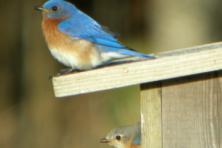Door to Nature: Drastic Effects of Global Climate Change
- Share
- Tweet
- Pin
- Share

I wondered what subject I should write about for the middle of June. Many wildflowers are in bloom, and a great variety of birds are still nesting and singing. However, as I walked down my 900-foot-long driveway on June 1, I saw lots of green sugar maple leaves that had fallen. It was even worse the next day.
I keep daily weather records, and now, as I write this on June 5, we have gone 28 days without rain. My April total of rain and melted snow was only 2.3 inches. I had 2.65 inches during the first week of May. So, in two months, my land has received only 5 inches of precipitation. During the growing season, we need about an inch per week.
The large deciduous trees are under great stress, going without water for a month. It is especially hard on them when they grow in shallow soil within a few inches of bedrock. Many farmers have made their first cutting of hay and might not have a second. Large fields that were planted with corn or grain are dry, and there is slow development of the new plants.
The cherry orchards had a very good bloom, but one wonders whether any of the cherries will be more than a red skin covering the pit. My flower beds require watering every day. The three bird baths that grace my front yard must be filled two or three times a day.
Of special note, there was a porcupine near the bath at dusk last night. I never see porcupines in my woods. And this morning at 6:15, as I was about to put out the suet feeder, a red-tailed hawk flew away from the bird baths. All creatures are in search of water!
We have seen how storms and hurricanes have become more intense, and there are so many areas of flash flooding. It seems this has been getting worse over the past few years. Climate change can also bring long dry spells where they do not normally occur.
Last summer, my part of Door County received only 1.4 inches of rain in June and just 1.6 inches in July. It was a poor year to study wild mushrooms because very few grew during that dry year. The greater the length of dry weather, the more the mushroom mycelium dries out and goes dormant. Then the soil needs huge amounts of rain over a long time to revive the fungus growth, plus more rain to make the mushrooms appear above the ground.
I have scheduled 19 mushroom hikes in Door County for late summer and fall this year. It will be interesting to see whether some of the first ones will have to be canceled due to the drought. During these long, dry spells, even the fungi that grow on trees may be slow to develop.
It was exactly 30 years ago that the Upper Midwest endured flooding rains from May until early autumn, and we were seeing more mushrooms than ever because of the constant moisture. I remember the week I taught a class at The Clearing in Ellison Bay during that time. In four days of collecting, we were able to identify 86 species of mushrooms.
I had been leading mushroom hikes at Whitefish Dunes State Park several times a year since 1990, and an average of about eight people joined me on the walks. In August of 1993, 44 people went on one of my hikes. They were seeing mushrooms all over and wanted to learn more about them.
If you have bird feeders in your yard, you probably have a bird bath or two. During these dry times, it is wise to make some mud puddles near the baths. I have done that, and it is making the resident female robin happy because robins and eastern phoebes need mud for the base of their nests. A few other species such as black-capped chickadees may also require mud or some wet moss.
Raccoons are always searching for tidbits that fall from the bird feeders. They come out of their daytime resting areas at dusk to eat cracked corn that I scatter on the ground, and then they drink a lot of the water in my three bird baths. I’ve seen deer come through the woods and drink at the baths, too.
Please keep your bird baths clean and filled for all the wildlife that may suffer during these drastic drought conditions.



